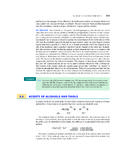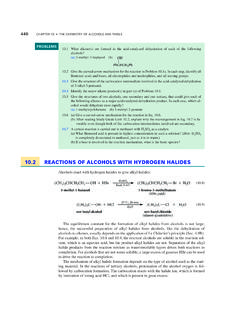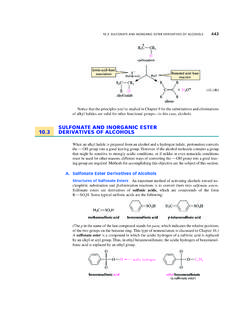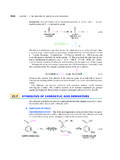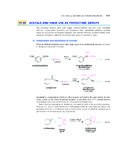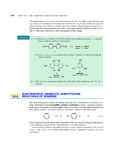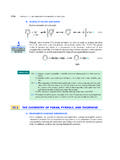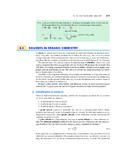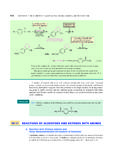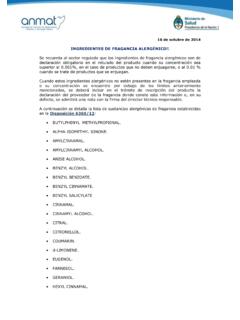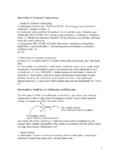Transcription of 17.5 ALLYLIC AND BENZYLIC OXIDATION - Sapling …
1 ALLYLIC AND BENZYLIC AND BENZYLIC OXIDATIONA. OXIDATION of ALLYLIC and BENZYLIC AlcoholsAllylic and BENZYLIC alcohols are oxidized selectively by a suspension of activated man-ganese(IV) dioxide, MnO2. Primary ALLYLIC alcohols are oxidized to aldehydes and secondaryallylic alcohols are oxidized to ketones.( )CCCH3CH2 HHCH3CH2 HCH2 OHMnO2CH2Cl2(solvent)(insoluble)+CCHCHO+ Mn(OH)2(E)-2-penten-1-ol(E)-2-pentenal(8 3% yield)( )CH3 OCH3 OCH2OH++MnO2Mn(OH)2CH2Cl2(solvent)(insol uble)CHO(4-methoxyphenyl)methanol(p-meth oxybenzyl alcohol)4-methoxybenzaldehyde(81% yield) how and why the product(s) would differ in the following reactions of trans-2-buten-1-ol.(1) Reaction with concentrated aqueous HBr(2) Conversion into the tosylate, then reaction with NaBr in acetonePROBLEMCXNucd ddNucd ddd of 2p orbitals(a)(b)HH HHH2 CCHH3 CCH2 CFigure states for SN2 reactions at (a) an ALLYLIC carbon and (b) a nonallylic carbon.
2 Nuc and X arethe nucleophile and leaving group, respectively. The ALLYLIC substitution is faster because the transition state is sta-bilized by overlap (blue lines) of the 2porbital at the site of substitution with the adjacent 12/9/08 11:29 AM Page 803804 CHAPTER 17 ALLYLIC AND BENZYLIC REACTIVITY Activated MnO2 is obtained by the OXIDATION reduction reaction of potassium perman-ganate, KMnO4, with an Mn2|salt such as MnSO4under either alkaline or acidic conditionsfollowed by thorough and BENZYLIC OXIDATION of alcohols takes place on the surface of the MnO2, which is in-soluble in the solvents used for the reaction. Water competes with alcohol for the sites on theMnO2and thus must be removed by drying to produce an active selectivity of MnO2oxidation for ALLYLIC and BENZYLIC alcohols is illustrated by the fol-lowing example.(This example illustrates the selectivity for BENZYLIC alcohols; a corresponding selectivity isobserved for ALLYLIC alcohols.)
3 The reaction is selective because ALLYLIC and BENZYLIC alcohols react much more rapidlythan ordinary alcohols. An understanding of this selectivity comes from the mechanism. Inthe first step of the mechanism, the O H group of the alcohol rapidly adds to MnO2to givean ester (Sec. ). (The solid-state structures of the Mn-containing species are simplified in these equations.) Inthe next step, which is rate-limiting, Mn(IV) accepts an electron to become Mn(III), and, at thesame time, a hydrogen atom is transferred from the ALLYLIC or BENZYLIC carbon to an oxygen ofthe oxidant. The product has an unpaired electron on the ALLYLIC or BENZYLIC carbon and istherefore a resonance-stabilized radical. ( ) (IV)Mn(III)an ALLYLIC or BENZYLIC radicalis resonance-stabilized( )CH2 ROH+OOMnCH2 ROOOHMn(in solution)(on the MnO2 surface)( )CH3 OCH3 Oacetone(solvent)CHCH2CH2 OHCH3 OCH3 OCOCH2CH2 OHOHMnO23,4-dimethoxyphenyl-1,3-propaned iol3,4-dimethoxyphenyl-3-hydroxy-1-propa none(94% yield)the BENZYLIC alcoholis selectively oxidized( )2 H2O3 MnSO45 MnO22 KMnO4K2SO42 H2SO4H2O++++ 12/9/08 11:29 AM Page ALLYLIC AND BENZYLIC OXIDATION805 The stability of the radical intermediate, by Hammond s postulate (Sec.)
4 , increases therate of this step. The ALLYLIC / BENZYLIC selectivity occurs because the analogous radical interme-diate in the OXIDATION of an alcohol that is not ALLYLIC or BENZYLIC is less stable and is formedmore slowly. In the rapid final step, Mn(III) is reduced to the more stable Mn(II), and a strongCAO double bond is formed to give the aldehyde product, which is washed away from theoxidant surface by the Give the structure of the product expected when each of the following alcohols is subjectedto MnO2oxidation.(a)(b) (c)(d) In each case, give the structure of a starting material that would give the product shown byMnO2oxidation.(a)(b) (c) In each case, tell whether OXIDATION with pyridinium chlorochromate (PCC) and oxidationwith MnO2would give the same product, different products, or no reaction. Explain.(a)(b) (c)(d) B. BENZYLIC OXIDATION of AlkylbenzenesTreatment of alkylbenzene derivatives with strong oxidizing agents under vigorous conditionsconverts the alkyl side chain into a carboxylic acid group.
5 Oxidants commonly used for thispurpose are Cr(VI) derivatives, such as Na2Cr2O7(sodium dichromate) or CrO3; the Mn(VII)CH2 OHHOCH2 COHCH3CH3 HOOHHOCH2 OOOCHCH2 OHHOHCH3CH2CH2 CCCH2 OHO2 NCHCH3 OHSCH2OH( ) (III)Mn(II)CHRO+..(dissolves inthe solvent) 12/9/08 11:29 AM Page 805806 CHAPTER 17 ALLYLIC AND BENZYLIC REACTIVITY reagent KMnO4(potassium permanganate); or O2and special catalysts, a procedure that isused industrially (Eq. , p. 778).Notice that the benzene ring is left intact, and notice from Eq. that the alkyl side chain,regardless of length,is converted into a carboxylic acid group. This reaction is useful for thepreparation of some carboxylic acids from of alkyl side chains requires the presence of a BENZYLIC hydrogen. Consequently,tert-butylbenzene, which has no BENZYLIC hydrogen, is resistant to BENZYLIC OXIDATION . Althoughwe won t consider the mechanisms of these BENZYLIC oxidations, they occur in many cases be-cause resonance-stabilized BENZYLIC intermediates such as BENZYLIC radicals are conditions for this side-chain OXIDATION are generally vigorous: heat, high concentra-tions of oxidant, and/or long reaction times.
6 It is also possible to effect less extensive oxidationsof side-chain groups. Thus 1-phenylethanol is readily oxidized to acetophenone under milderconditions the normal OXIDATION of secondary alcohols to ketones (Sec. ) but it is con-verted into benzoic acid under more vigorous u d o n o t n e e d t o b e c o n c e r n e d w i t h l e a r n i n g t h e e x a c t c o n d i t i o n s f o r t h e s e r e a c t i o n s ; r a t h e r,it is important simply to be aware that it is usually possible to find appropriate conditions foreach type of OXIDATION . (See Study Guide Link ) Give the products of vigorous KMnO4oxidation of each of the following compounds.(a) p-nitrobenzyl alcohol(b)1-butyl-4-tert-butylbenzene( )CHCH3cLCOCH3 ccCr(VI)mildCr(VI)vigorousCr(VI)vigorous LLLLSCOHO benzoic acidacetophenone1-phenylethanolLS"OH( )CrO3, 40% H2SO448 h, 100 CCH2CH2CH3cLpropylbenzeneCO2 HcLbenzoic acid(55% yield)( )CH3 ClKMnO4100 C, 3 4 hH2Ov$Lo-chlorotolueneCO2 HClv$L2-chlorobenzoic acid(77% yield)STUDY GUIDE LINK 12/9/08 11:29 AM Page (a)A compound Ahas the formula C8H10.
7 After vigorous OXIDATION , it yields phthalic is the structure of A?(b) A compound Bhas the formula C8H10. After vigorous OXIDATION , it yields benzoic acid(structure in Eq. ). What is the structure of B? The Isoprene RulePeople have long been fascinated with the pleasant-smelling substances found in plants forexample, the perfume of a rose and have been curious to learn more about these materials,which have come to be called essential essential oilis a substance that possesses akey characteristic, such as an odor or flavor, of the natural material from which it comes. (SeeFurther Exploration )Essential oils, particularly oil of turpentine, were known to the ancient Egyptians. How-ever, not until early in the nineteenth century was an effort made to determine the chemicalconstitution of the essential oils. In 1818, it was found that the C : H ratio in oil of turpentinewas 5 : 8.
8 This same ratio was subsequently found for a wide variety of natural products. Theserelated natural products became known collectively as terpenes,a name coined by AugustKekul (p. 47). The similarity in the atomic compositions of the many terpenes led to the ideathat they might possess some unifying structural 1887, the German chemist Otto Wallach (1847 1931), who received the 1910 NobelPrize in Chemistry, pointed out the common structural feature of the terpenes: they all consistof repeating units that have the same carbon skeleton as the five-carbon diene isoprene. Thisgeneralization subsequently became known as theisoprene example, citronellol (from oil of roses and other sources) incorporates two isoprene units:""SH2CH2 CCCCH2CH3 CHCH2 OHH3 CCH3H%%%%%citronellolisoprenecarbon skeletonisoprenecarbon skeleton%OH( )carbon-1carbon-4H2 CCHCCH2CH3%isoprenethe carbon skeletonof isoprene##"""%%%phthalic acidCO2Hi%CO2H%Further Exploration 12/9/08 11:29 AM Page 807
